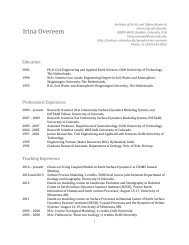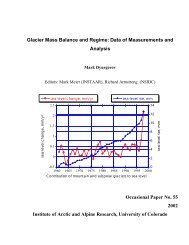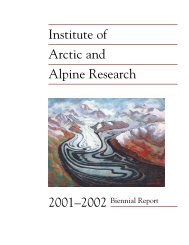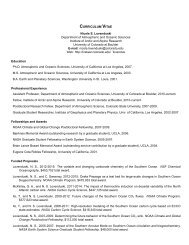The spread of modern humans in Europe - Proceedings of the ...
The spread of modern humans in Europe - Proceedings of the ...
The spread of modern humans in Europe - Proceedings of the ...
You also want an ePaper? Increase the reach of your titles
YUMPU automatically turns print PDFs into web optimized ePapers that Google loves.
however, and many artifact assemblages dat<strong>in</strong>g to this periodcannot be firmly attributed to one taxon or <strong>the</strong> o<strong>the</strong>r. <strong>The</strong>se<strong>in</strong>clude assemblages that are not associated with diagnostichuman fossils and conta<strong>in</strong> a comb<strong>in</strong>ation <strong>of</strong> artifact typestraditionally assigned to Middle and Upper Paleolithic. <strong>The</strong>y are<strong>of</strong>ten <strong>in</strong>terpreted as manifestations <strong>of</strong> cultural <strong>in</strong>fluence betweenNeanderthals and <strong>modern</strong> <strong>humans</strong> (11), but <strong>the</strong>re areo<strong>the</strong>r reasons typical Middle and Upper Paleolithic artifactforms might be found toge<strong>the</strong>r <strong>in</strong> <strong>the</strong> same occupation (12).Although stone blade technology is traditionally associated withUpper Paleolithic <strong>in</strong>dustries, it became apparent many years agothat Middle Paleolithic <strong>in</strong>dustries <strong>in</strong> various parts <strong>of</strong> Eurasiayield evidence <strong>of</strong> blade production. Blade manufacture is welldocumented <strong>in</strong> <strong>the</strong> Middle Paleolithic <strong>of</strong> <strong>Europe</strong> and <strong>the</strong> NearEast (13, 14).If Neanderthals produced at least some <strong>of</strong> <strong>the</strong> stone artifactforms found <strong>in</strong> Upper Paleolithic assemblages, anatomically<strong>modern</strong> <strong>humans</strong> cont<strong>in</strong>ued to manufacture and use many typicalMiddle Paleolithic forms long after <strong>the</strong> transition. Production <strong>of</strong>side-scrapers, po<strong>in</strong>ts, small bifaces, and o<strong>the</strong>r such forms cont<strong>in</strong>ued<strong>in</strong>to <strong>the</strong> Upper Paleolithic and post-Paleolithic <strong>in</strong>dustries.In North America, such artifacts are common <strong>in</strong> Paleo<strong>in</strong>diansites, where <strong>the</strong>y are <strong>of</strong>ten associated with <strong>the</strong> kill<strong>in</strong>g andbutcher<strong>in</strong>g <strong>of</strong> large mammals (e.g., refs. 15 and 16). In <strong>Europe</strong>,Middle Paleolithic tool types also are present <strong>in</strong> Upper Paleolithicassemblages, but usually <strong>in</strong> low percentages <strong>in</strong> <strong>the</strong> naturalshelters <strong>of</strong> Western <strong>Europe</strong>. In <strong>the</strong> open-air sites (and somenatural shelters) <strong>of</strong> Central and Eastern <strong>Europe</strong>, <strong>the</strong>y are morecommon and <strong>of</strong>ten abundant (17).At both open-air localities and natural shelters where UpperPaleolithic occupations directly overlie those <strong>of</strong> <strong>the</strong> MiddlePaleolithic, <strong>the</strong> mix<strong>in</strong>g <strong>of</strong> artifacts from different levels representsano<strong>the</strong>r potential source <strong>of</strong> assemblages conta<strong>in</strong><strong>in</strong>g typicalforms from both <strong>in</strong>dustries. In addition to potential deposition<strong>of</strong> Neanderthal and <strong>modern</strong> human artifacts on <strong>the</strong> same surface,postdepositional mix<strong>in</strong>g <strong>of</strong> surface and buried artifacts caused bytrampl<strong>in</strong>g or frost action is possible (18).Ano<strong>the</strong>r problem is <strong>the</strong> dat<strong>in</strong>g <strong>of</strong> sites and occupation levels<strong>in</strong>habited dur<strong>in</strong>g <strong>the</strong> transition period. Much <strong>of</strong> MIS 3 liesbeyond <strong>the</strong> effective range <strong>of</strong> radiocarbon and many dates(especially on bone) likely have been contam<strong>in</strong>ated by youngercarbon. Even dates that appear to be valid must be calibrated toaccount for <strong>the</strong> effects <strong>of</strong> past fluctuations <strong>in</strong> atmosphericradiocarbon, especially elevated dur<strong>in</strong>g <strong>the</strong> cosmogenic nuclidepeak at 40,000 cal BP. In this article, radiocarbon measurementshave been calibrated with <strong>the</strong> CalPal-2007 curve (19). <strong>The</strong>application <strong>of</strong> o<strong>the</strong>r dat<strong>in</strong>g techniques, <strong>in</strong>clud<strong>in</strong>g opticalstimulatedlum<strong>in</strong>escence and electron sp<strong>in</strong> resonance, has improvedchronological control, and several wide<strong>spread</strong> chronostratigraphicmarkers, such as <strong>the</strong> CI volcanic tephra and <strong>the</strong>Laschamp paleomagnetic excursion, have provided additionalcontrol <strong>in</strong> some places (9).Modern Humans as a Coloniz<strong>in</strong>g SpeciesModern <strong>humans</strong> entered <strong>Europe</strong> as a coloniz<strong>in</strong>g species andprobably were characterized by comparatively low populationdensity as <strong>the</strong>y expanded <strong>in</strong>to previously unoccupied territoryand adapted to new environmental conditions (20). Low densitymight be expressed <strong>in</strong> terms <strong>of</strong> smaller residential group sizeand/or larger home ranges and higher mobility requirements.<strong>The</strong> <strong>in</strong>itial phase <strong>of</strong> <strong>modern</strong> human settlement <strong>in</strong> <strong>Europe</strong><strong>the</strong>refore could be represented by a relatively small number <strong>of</strong>archaeological sites and human skeletal rema<strong>in</strong>s per unit area.<strong>The</strong>ir visibility probably would be even lower <strong>in</strong> landscapeswhere natural shelters are scarce or absent.However, <strong>the</strong>re is reason to believe that <strong>modern</strong> <strong>humans</strong> hadacquired some unique abilities to colonize new environments.Behavioral <strong>modern</strong>ity is <strong>of</strong>ten identified with <strong>the</strong> use <strong>of</strong> symbols(21), which is most clearly manifest <strong>in</strong> syntactical language.Language and o<strong>the</strong>r uses <strong>of</strong> symbols are, however, part <strong>of</strong> abroader capacity to create complex, hierarchically organizedstructures (sometimes labeled recursion) <strong>in</strong> a variety <strong>of</strong> mediaboth symbolic and nonsymbolic (22). <strong>The</strong> latter <strong>in</strong>clude technology,which exhibits a pattern <strong>of</strong> accelerat<strong>in</strong>g <strong>in</strong>novation andexpand<strong>in</strong>g complexity dur<strong>in</strong>g <strong>the</strong> Upper Paleolithic (23). <strong>The</strong> use<strong>of</strong> symbols also may have conferred some unique organizationalabilities on <strong>modern</strong> <strong>humans</strong> (24), and <strong>the</strong> creation <strong>of</strong> noveltechnologies and organizational structures may have played asignificant role <strong>in</strong> <strong>the</strong> dispersal <strong>of</strong> <strong>modern</strong> <strong>humans</strong> and <strong>the</strong>irseem<strong>in</strong>gly rapid colonization <strong>of</strong> a variety <strong>of</strong> habitats and climatezones.Ano<strong>the</strong>r factor is <strong>the</strong> presence <strong>of</strong> competitor species. BothNeanderthals and hyenas represent likely competitors for <strong>modern</strong><strong>humans</strong> <strong>in</strong> <strong>Europe</strong>, especially with respect to large mammalprey. With this <strong>in</strong> m<strong>in</strong>d, it should be noted that comparativeanalysis <strong>of</strong> stable isotope values for Neanderthal and hyena bonefrom a cave <strong>in</strong> France (late MIS 3) suggests that emphasis onsuperherbivores (mammoth and rh<strong>in</strong>oceros) by <strong>the</strong> former reducedresource competition with hyenas (25). As for <strong>modern</strong> <strong>humans</strong>,<strong>the</strong>re is evidence for exploitation <strong>of</strong> smaller vertebrates, whichmight have reduced niche overlap with both competitors (26).South-Central <strong>Europe</strong><strong>The</strong> earliest credible evidence for <strong>modern</strong> <strong>humans</strong> <strong>in</strong> <strong>Europe</strong> isagroup<strong>of</strong>artifactassemblagesfound<strong>in</strong>South-Central<strong>Europe</strong>,assigned to <strong>the</strong> Bohunician <strong>in</strong>dustry, that are similar to assemblages<strong>of</strong> comparable age <strong>in</strong> <strong>the</strong> Near East associated <strong>in</strong>directlywith skeletal rema<strong>in</strong>s <strong>of</strong> <strong>modern</strong> <strong>humans</strong>. <strong>The</strong>y are found at <strong>the</strong>type site <strong>of</strong> Brno-Bohunice and Stránská skála (Moravia), BachoKiro and Temnata Cave (Bulgaria), Dzierzyslaw (Poland), ando<strong>the</strong>rs (27, 28). <strong>The</strong>y conta<strong>in</strong> Levallois cores used to produceflakes and blades with hard-hammer percussion and retouchedpieces <strong>in</strong>clud<strong>in</strong>g a variety <strong>of</strong> side-scrapers, po<strong>in</strong>ts, end-scrapers,and simple bur<strong>in</strong>s; some assemblages also conta<strong>in</strong> bifacial leafshapedpo<strong>in</strong>ts (29). An associated human mandible fragmentrecovered from layer 11 at Bach Kiro is <strong>of</strong> uncerta<strong>in</strong> taxonomicaffiliation (10).Although a case for local Middle Paleolithic orig<strong>in</strong> has beenmade (30), many archaeologists perceive stronger similaritiesbetween <strong>the</strong> Bohunician and contemporaneous assemblages <strong>in</strong><strong>the</strong> Near East, specifically at Bocher Tachtit, layers 1–3 (Israel),Ksar Akil, layers XXV-XXI (Lebanon), and Üçağizli Cave,layers F-H (Turkey), and little evidence <strong>of</strong> cont<strong>in</strong>uity with lateMiddle Paleolithic <strong>in</strong>dustries <strong>of</strong> Central <strong>Europe</strong> (31, 32). <strong>The</strong>Near Eastern assemblages, which are assigned to <strong>the</strong> Emiran<strong>in</strong>dustry [or simply Initial Upper Paleolithic (IUP)], lack associatedhuman skeletal rema<strong>in</strong>s. <strong>The</strong>y appear, however, to representpart <strong>of</strong> a local developmental cont<strong>in</strong>uum that subsequentlyyielded a related <strong>in</strong>dustry (Ahmarian) associated with <strong>modern</strong>human rema<strong>in</strong>s <strong>in</strong> layer XVII at Ksar Akil (33). Moreover, <strong>the</strong>Emiran reflects broader trends <strong>in</strong> technology observed <strong>in</strong> NorthAfrica at older sites like Taramsa 1 (Nile Valley), which conta<strong>in</strong>s<strong>modern</strong> human rema<strong>in</strong>s dated to 75,000 years ago (34).Assemblages assigned to <strong>the</strong> Bohunician <strong>in</strong> South-Central<strong>Europe</strong> are dated by radiocarbon and lum<strong>in</strong>escence to 48,000–40,000 cal BP (35). <strong>The</strong>y are associated with two buried soils thatdate to <strong>the</strong> MIS 3 <strong>in</strong>terval and correlate with GI 12–GI 9 <strong>in</strong> <strong>the</strong>Greenland ice core record. <strong>The</strong> Bohunician appears at <strong>the</strong>beg<strong>in</strong>n<strong>in</strong>g <strong>of</strong> a major warm <strong>in</strong>terval (GI 12) and term<strong>in</strong>atesbefore a major cold period (HE4). <strong>The</strong> apparent l<strong>in</strong>k between<strong>the</strong> Bohunician and GI 12 may be significant, because one <strong>of</strong> <strong>the</strong>strik<strong>in</strong>g characteristics <strong>of</strong> this <strong>in</strong>dustry, given its postulated statusas a proxy for <strong>the</strong> <strong>in</strong>itial movement <strong>of</strong> <strong>modern</strong> <strong>humans</strong> <strong>in</strong>to<strong>Europe</strong>, is <strong>the</strong> scarcity <strong>of</strong> evidence for <strong>in</strong>novative technology.With <strong>the</strong> exception <strong>of</strong> a perforator from layer 11 <strong>of</strong> Bacho Kiro(36), Bohunician sites lack bone implements and o<strong>the</strong>r evidenceANTHROPOLOGY SPECIAL FEATUREH<strong>of</strong>fecker PNAS September 22, 2009 vol. 106 no. 38 16041
















